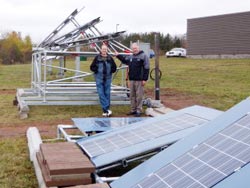Amping Up Solar in the Snowy North

Marcia Goodrich/Michigan Technological University<br><br>Michigan Tech solar energy scientist Joshua Pearce, left, and Jay Meldrum, director of the Keweenaw Research Center, with the array of solar panels behind KRC. Even on this gloomy day, they were cranking out electricity.<br>
Michigan Technological University’s Keweenaw Research Center (KRC) is now part of a two-year study that will help answer that question. The aims are to gauge how snow affects solar panels’ power generation and determine the best ways to overcome any losses.
The international engineering firm DNV GL, which specializes in large energy- and sustainability-related projects, has built an array of solar photovoltaic panels behind KRC, each set at a different angle, from 0 degrees (flat) to 45 degrees. “If you tilt them at 60 degrees, almost no snow sticks to the panels, but you also lose a lot of sunlight when they are not facing the sky,” said Tim Townsend, a principal engineer for solar services with DNV GL.
Based on similar studies, year-round losses can be anywhere from a few percent (as found by Michigan Tech in a study looking at Ontario data) to 12 percent (39 degree tilt) to 18 percent (0 degree tilt), which Townsend measured near Lake Tahoe in California. Townsend’s group developed a model to predict how snowfall and other related variables would affect energy generation. Now, they will test their model in collaboration with Michigan Tech using data from the KRC solar array and other test sites in Colorado, Pennsylvania and California.
A small variance in power generation may not make a big difference for a homeowner with solar panels. However, it’s a big deal in industry.
“We do predictions on behalf of commercial lenders being asked to foot the bill for big solar arrays,” said Townsend. Good data “makes them more financeable.” Eventually, the study results will be publicly available through the KRC website and through solar energy simulation programs provided by the US National Renewable Energy Laboratory.
“Everybody who wants to develop solar energy in snowy climates on a large scale will need this data,” said Joshua Pearce, an associate professor of materials science and engineering/electrical and computer engineering at Michigan Tech, who is participating in the project. “In the olden days, you’d only see solar farms in places like Arizona, and Spain. Now, large solar installations are found throughout the northern US and Canada.”
Meanwhile, KRC plans to apply the lessons learned from the test solar panels in its own back yard. “Michigan Tech will be going full bore on stopping snow losses,” said KRC Director Jay Meldrum.
In addition, KRC is testing another method to boost its solar power generation. They will be adjusting the panels' angles throughout the year to track the seasonal position of the sun, which is close to the horizon in winter and nearly directly overhead at the summer solstice. “Pointing the array at the proper altitude can help to maximize energy generation while reducing snow losses,” Meldrum said. You can view both tests on the KRC webcams.
Marcia Goodrich, writer, mtunews@mtu.edu, 906-487-2343
Joshua Pearce, pearce@mtu.edu, 906-487-1466
Jay Meldrum, jmeldrum@mtu.edu, 906-487-3178
Media Contact
More Information:
http://www.mtu.eduAll latest news from the category: Studies and Analyses
innovations-report maintains a wealth of in-depth studies and analyses from a variety of subject areas including business and finance, medicine and pharmacology, ecology and the environment, energy, communications and media, transportation, work, family and leisure.
Newest articles

Innovative 3D printed scaffolds offer new hope for bone healing
Researchers at the Institute for Bioengineering of Catalonia have developed novel 3D printed PLA-CaP scaffolds that promote blood vessel formation, ensuring better healing and regeneration of bone tissue. Bone is…

The surprising role of gut infection in Alzheimer’s disease
ASU- and Banner Alzheimer’s Institute-led study implicates link between a common virus and the disease, which travels from the gut to the brain and may be a target for antiviral…

Molecular gardening: New enzymes discovered for protein modification pruning
How deubiquitinases USP53 and USP54 cleave long polyubiquitin chains and how the former is linked to liver disease in children. Deubiquitinases (DUBs) are enzymes used by cells to trim protein…



